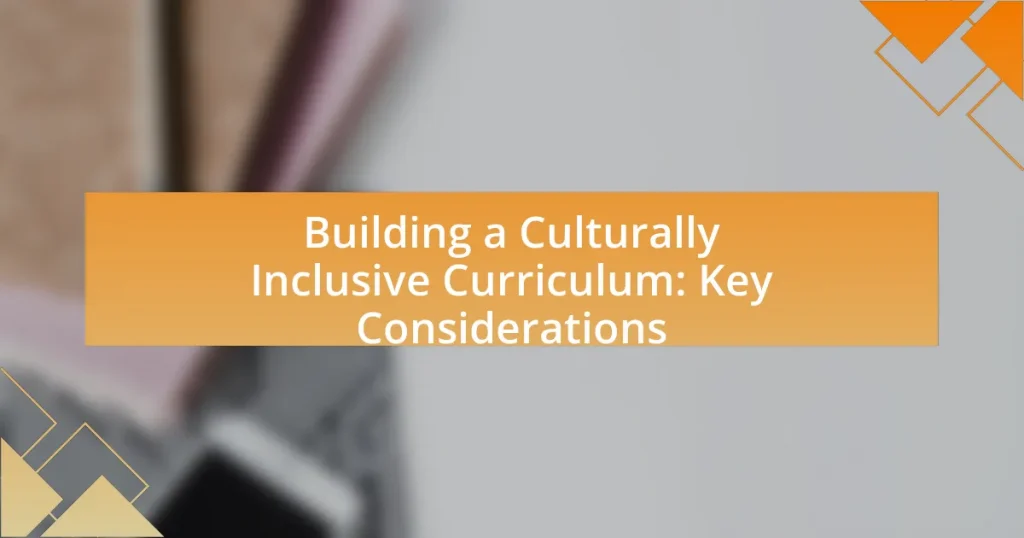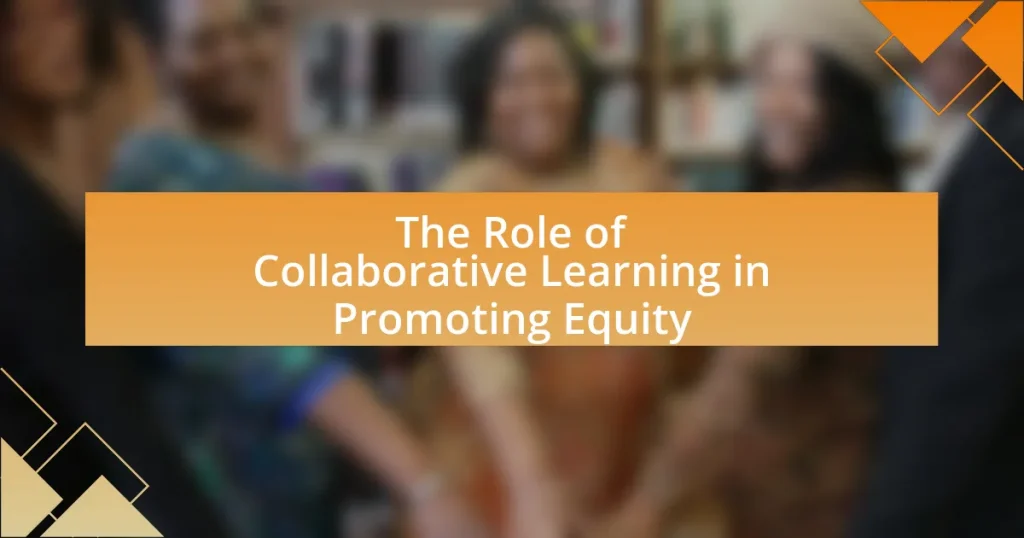A culturally inclusive curriculum is an educational framework that integrates diverse cultural perspectives, histories, and contributions, ensuring all students see their identities reflected in the learning process. This article outlines the importance of such a curriculum in promoting equity, enhancing student engagement, and improving academic outcomes. Key components include diverse representation, culturally relevant pedagogy, and an emphasis on social justice. The article also discusses strategies for educators to identify and integrate diverse cultural perspectives, the challenges they may face, and the resources available to support the development of an inclusive curriculum. Additionally, it highlights the role of technology and ongoing professional development in fostering cultural competency among educators.

What is a Culturally Inclusive Curriculum?
A culturally inclusive curriculum is an educational framework that integrates diverse cultural perspectives, histories, and contributions into the learning process. This approach ensures that all students see their identities and experiences reflected in the curriculum, promoting equity and understanding among different cultural groups. Research indicates that culturally inclusive curricula can enhance student engagement and academic achievement by fostering a sense of belonging and relevance in the classroom. For instance, studies show that when students learn about their own cultures alongside others, they are more likely to succeed academically and develop critical thinking skills.
Why is a Culturally Inclusive Curriculum important?
A culturally inclusive curriculum is important because it fosters an environment where all students feel valued and represented, enhancing their engagement and learning outcomes. Research indicates that students who see their cultures reflected in the curriculum are more likely to participate actively and perform better academically. For instance, a study by the National Education Association found that culturally relevant pedagogy can lead to improved student achievement and a decrease in dropout rates among minority students. This approach not only promotes equity in education but also prepares students for a diverse society by encouraging respect and understanding among different cultural perspectives.
How does it impact student engagement and learning outcomes?
Building a culturally inclusive curriculum significantly enhances student engagement and learning outcomes. Research indicates that when students see their cultural backgrounds reflected in the curriculum, they are more likely to participate actively in class discussions and activities. For instance, a study by Gay (2010) in “Culturally Responsive Teaching: Theory, Research, and Practice” found that culturally relevant pedagogy leads to higher academic achievement and increased motivation among students from diverse backgrounds. This alignment between curriculum content and student identity fosters a sense of belonging, which is crucial for effective learning.
What role does cultural representation play in education?
Cultural representation plays a crucial role in education by fostering inclusivity and enhancing student engagement. When educational materials reflect diverse cultures, students from various backgrounds feel valued and understood, which can improve their academic performance and self-esteem. Research indicates that culturally relevant pedagogy, as discussed by Gloria Ladson-Billings in her work “The Dreamkeepers,” emphasizes the importance of incorporating students’ cultural references in all aspects of learning. This approach not only promotes a sense of belonging but also prepares all students to thrive in a multicultural society.
What are the key components of a Culturally Inclusive Curriculum?
The key components of a Culturally Inclusive Curriculum include diverse representation, culturally relevant pedagogy, and an emphasis on social justice. Diverse representation ensures that materials reflect a variety of cultures, histories, and perspectives, which fosters a sense of belonging among all students. Culturally relevant pedagogy connects students’ cultural contexts to the learning process, enhancing engagement and understanding. An emphasis on social justice encourages critical thinking about equity and inclusion, preparing students to navigate and challenge societal inequalities. These components collectively create an educational environment that values and respects all cultures, promoting a more equitable learning experience.
How can educators identify diverse cultural perspectives?
Educators can identify diverse cultural perspectives by actively engaging with their students’ backgrounds and experiences. This can be achieved through methods such as conducting surveys to gather information about students’ cultural identities, facilitating open discussions that encourage sharing of personal stories, and incorporating multicultural resources into the curriculum. Research indicates that when educators utilize culturally relevant pedagogy, they not only enhance student engagement but also foster an inclusive learning environment that respects and values diversity. For instance, a study by Ladson-Billings (1994) highlights the importance of recognizing students’ cultural contexts to improve educational outcomes.
What strategies can be employed to integrate these perspectives?
To integrate diverse perspectives in building a culturally inclusive curriculum, educators can employ strategies such as collaborative curriculum design, inclusive pedagogy, and community engagement. Collaborative curriculum design involves bringing together educators from various cultural backgrounds to co-create learning materials that reflect multiple viewpoints. Inclusive pedagogy focuses on teaching methods that accommodate diverse learning styles and cultural contexts, ensuring all students feel represented and valued. Community engagement entails involving local cultural groups in the curriculum development process, which can provide authentic insights and resources that enhance the educational experience. These strategies are supported by research indicating that inclusive curricula improve student engagement and academic performance across diverse populations.
What challenges might educators face in building a Culturally Inclusive Curriculum?
Educators face several challenges in building a Culturally Inclusive Curriculum, including a lack of resources, insufficient training, and resistance from stakeholders. The lack of resources can hinder the development of materials that accurately reflect diverse cultures, making it difficult to create an inclusive environment. Insufficient training for educators on cultural competency can lead to misunderstandings and ineffective teaching practices. Additionally, resistance from parents, administrators, or community members may arise due to differing beliefs about the importance of cultural inclusivity in education. These challenges can impede the successful implementation of a curriculum that embraces and celebrates diversity.
How can biases and stereotypes be addressed in curriculum design?
Biases and stereotypes can be addressed in curriculum design by incorporating diverse perspectives and materials that reflect a variety of cultures and experiences. This approach ensures that students encounter a balanced representation of different groups, which can counteract preconceived notions and promote understanding. Research indicates that inclusive curricula can enhance student engagement and academic performance, as demonstrated in a study by the American Educational Research Association, which found that students exposed to diverse content showed improved critical thinking skills and empathy. Additionally, involving community stakeholders in the curriculum development process can provide insights that help identify and mitigate biases, fostering a more equitable educational environment.
What resources are available to support educators in this process?
Educators can access various resources to support the development of a culturally inclusive curriculum, including professional development programs, online courses, and instructional materials. For instance, organizations like Teaching Tolerance provide free resources and lesson plans that promote diversity and inclusion in the classroom. Additionally, the National Education Association offers workshops and publications focused on culturally responsive teaching practices. Research indicates that implementing culturally inclusive curricula can enhance student engagement and academic achievement, as highlighted in studies by the American Educational Research Association.
How can educators assess the effectiveness of a Culturally Inclusive Curriculum?
Educators can assess the effectiveness of a Culturally Inclusive Curriculum by utilizing student feedback, performance metrics, and classroom observations. Student feedback can be gathered through surveys and discussions, allowing educators to understand how well the curriculum resonates with diverse cultural perspectives. Performance metrics, such as grades and standardized test scores, can indicate whether students from various backgrounds are achieving academic success. Classroom observations enable educators to evaluate engagement levels and interactions among students, providing insights into the curriculum’s inclusivity. Research shows that culturally responsive teaching practices lead to improved student outcomes, as highlighted in the study “Culturally Responsive Teaching: Theory, Research, and Practice” by Geneva Gay, which emphasizes the positive impact of culturally inclusive approaches on student engagement and achievement.
What metrics can be used to evaluate student understanding and inclusivity?
Metrics to evaluate student understanding and inclusivity include formative assessments, student feedback surveys, and participation rates in diverse activities. Formative assessments, such as quizzes and reflective journals, provide insights into individual comprehension levels and learning progress. Student feedback surveys gauge perceptions of inclusivity and engagement, revealing how well diverse perspectives are integrated into the curriculum. Participation rates in culturally diverse activities indicate the extent to which students feel included and represented, highlighting areas for improvement in curriculum design. These metrics collectively offer a comprehensive view of both understanding and inclusivity within educational settings.
How can feedback from students and parents inform curriculum adjustments?
Feedback from students and parents can significantly inform curriculum adjustments by providing insights into the effectiveness and relevance of educational content. This feedback allows educators to identify areas where students may struggle or feel disengaged, enabling targeted modifications to enhance learning experiences. For instance, surveys and focus groups can reveal students’ cultural backgrounds and interests, which can be integrated into the curriculum to make it more inclusive and representative. Research indicates that culturally responsive teaching improves student engagement and achievement, as highlighted in the study “Culturally Responsive Teaching: Theory, Research, and Practice” by Geneva Gay, which emphasizes the importance of incorporating students’ cultural contexts into educational practices.

How can educators implement a Culturally Inclusive Curriculum?
Educators can implement a Culturally Inclusive Curriculum by integrating diverse cultural perspectives into lesson plans and materials. This involves selecting texts, resources, and examples that reflect the backgrounds and experiences of all students, thereby promoting representation and relevance. Research indicates that culturally responsive teaching enhances student engagement and academic performance, as evidenced by a study published in the “Journal of Educational Psychology,” which found that students from diverse backgrounds perform better when their cultural identities are acknowledged in the curriculum. Additionally, educators should engage with the community to understand cultural contexts and incorporate local histories and traditions into their teaching, fostering a more inclusive learning environment.
What steps should be taken to begin the implementation process?
To begin the implementation process of a culturally inclusive curriculum, the first step is to conduct a comprehensive needs assessment to identify the specific cultural contexts and needs of the student population. This assessment should involve gathering data through surveys, interviews, and focus groups with students, parents, and educators to understand their perspectives and experiences. Following the assessment, the next step is to develop clear objectives that align with the identified needs, ensuring that the curriculum reflects diverse cultural perspectives and promotes inclusivity.
Additionally, it is essential to engage stakeholders, including teachers and community members, in the planning process to foster collaboration and buy-in. This collaborative approach can enhance the curriculum’s relevance and effectiveness. Finally, establishing a timeline and allocating resources for training educators on culturally responsive teaching practices will facilitate a smooth implementation process. Research indicates that inclusive curricula can improve student engagement and academic outcomes, highlighting the importance of these steps in fostering an equitable learning environment.
How can collaboration with community members enhance curriculum development?
Collaboration with community members enhances curriculum development by integrating diverse perspectives and local knowledge into educational content. This engagement ensures that the curriculum reflects the cultural, social, and economic realities of the community, making learning more relevant and meaningful for students. Research indicates that when educators involve community stakeholders, such as parents and local organizations, the curriculum becomes more inclusive and responsive to the needs of all students, fostering a sense of belonging and engagement. For example, a study by the National Education Association found that schools that actively collaborate with community members see improved student outcomes and increased parental involvement, demonstrating the positive impact of such partnerships on curriculum effectiveness.
What training opportunities exist for educators to improve cultural competency?
Training opportunities for educators to improve cultural competency include workshops, online courses, and professional development programs specifically focused on diversity and inclusion. For instance, organizations like the National Education Association offer resources and training sessions aimed at enhancing educators’ understanding of cultural differences and effective teaching strategies. Additionally, universities often provide graduate-level courses in multicultural education, which equip teachers with the necessary skills to address diverse student needs. Research indicates that educators who participate in such training demonstrate improved cultural awareness and teaching effectiveness, ultimately benefiting student engagement and learning outcomes.
What role does technology play in supporting a Culturally Inclusive Curriculum?
Technology plays a crucial role in supporting a Culturally Inclusive Curriculum by providing diverse resources and facilitating access to varied cultural perspectives. Digital platforms enable educators to incorporate multimedia content, such as videos, articles, and interactive tools, that reflect the experiences and histories of different cultural groups. For instance, research by the International Society for Technology in Education highlights that technology can enhance engagement and understanding by allowing students to explore cultural narratives through virtual reality experiences or online collaborative projects. This access to a wide range of cultural materials fosters an inclusive learning environment, promoting empathy and respect among students from diverse backgrounds.
How can digital resources be utilized to promote diverse perspectives?
Digital resources can be utilized to promote diverse perspectives by providing access to a wide range of voices, narratives, and educational materials that reflect various cultures and experiences. For instance, online platforms like digital libraries and educational websites offer multicultural literature, historical documents, and multimedia content that showcase different viewpoints. Research indicates that exposure to diverse perspectives enhances critical thinking and empathy among learners, as evidenced by studies such as “The Impact of Diverse Perspectives on Learning” published in the Journal of Educational Psychology, which found that students who engaged with varied cultural materials demonstrated improved understanding and acceptance of different viewpoints.
What are the potential pitfalls of relying on technology in curriculum design?
Relying on technology in curriculum design can lead to several potential pitfalls, including over-dependence on digital tools, which may diminish critical thinking and interpersonal skills among students. When educators prioritize technology, they may inadvertently neglect essential pedagogical strategies that foster engagement and collaboration. Research indicates that excessive screen time can negatively impact students’ attention spans and social interactions, as highlighted in a study by the American Academy of Pediatrics, which found that children who spend more than two hours a day on screens are at risk for behavioral issues. Additionally, technology can exacerbate inequalities, as not all students have equal access to devices and reliable internet, leading to a digital divide that hinders equitable learning opportunities.

What best practices can be adopted for a Culturally Inclusive Curriculum?
To create a culturally inclusive curriculum, educators should integrate diverse perspectives and materials that reflect the backgrounds of all students. This can be achieved by incorporating literature, history, and examples from various cultures, ensuring that students see themselves represented in the curriculum. Research indicates that inclusive curricula improve student engagement and academic performance; for instance, a study by the National Education Association found that culturally relevant teaching practices can enhance student achievement and foster a sense of belonging. Additionally, involving families and communities in curriculum development can provide valuable insights and strengthen connections between school and home, further enriching the educational experience.
How can ongoing professional development support educators?
Ongoing professional development supports educators by enhancing their skills and knowledge, which directly improves their teaching effectiveness. Research indicates that continuous training allows educators to stay updated on the latest pedagogical strategies and cultural competencies, essential for creating inclusive curricula. For instance, a study by the National Staff Development Council found that effective professional development leads to a 21% increase in student achievement when educators apply new techniques learned through training. This ongoing support fosters a collaborative learning environment, enabling educators to share best practices and address diverse student needs more effectively.
What types of workshops or training sessions are most effective?
Interactive workshops and experiential training sessions are the most effective types of workshops or training sessions. These formats engage participants actively, fostering deeper understanding and retention of culturally inclusive practices. Research indicates that interactive methods, such as role-playing and group discussions, enhance learning outcomes by allowing participants to apply concepts in real-world scenarios. A study by the National Training Laboratory found that experiential learning can lead to retention rates as high as 75%, compared to traditional lecture-based sessions, which have retention rates around 5-10%. This evidence supports the effectiveness of interactive and experiential approaches in training for cultural inclusivity.
How can educators stay updated on cultural trends and educational research?
Educators can stay updated on cultural trends and educational research by actively engaging with professional development opportunities, subscribing to relevant journals, and participating in online communities. Professional development programs often include workshops and seminars that focus on current educational practices and cultural awareness, which can enhance educators’ understanding of diverse student needs. Subscribing to journals such as the “Journal of Educational Research” or “Cultural Studies of Science Education” provides access to peer-reviewed articles that discuss the latest findings in educational research and cultural trends. Additionally, joining online platforms like Edutopia or participating in social media groups dedicated to education allows educators to share resources and insights with peers, fostering a collaborative learning environment.
What practical tips can educators use to create a Culturally Inclusive Curriculum?
Educators can create a culturally inclusive curriculum by integrating diverse perspectives and materials that reflect the backgrounds of all students. This can be achieved by incorporating literature, historical accounts, and examples from various cultures into lesson plans, ensuring that students see themselves represented in the curriculum. Research indicates that students perform better academically when they feel their cultural identities are acknowledged and valued; for instance, a study by Gay (2010) highlights that culturally responsive teaching enhances student engagement and achievement. Additionally, educators should engage with families and communities to gather input on curriculum content, fostering a collaborative approach that respects and includes different cultural viewpoints.
How can lesson plans be adapted to include diverse cultural perspectives?
Lesson plans can be adapted to include diverse cultural perspectives by integrating multicultural content, utilizing diverse teaching materials, and encouraging student participation from various backgrounds. Incorporating multicultural content involves selecting texts, examples, and case studies that reflect a range of cultures and experiences, which fosters inclusivity and relevance. Utilizing diverse teaching materials, such as videos, art, and music from different cultures, enhances engagement and understanding. Encouraging student participation allows learners to share their cultural backgrounds and perspectives, promoting a richer classroom dialogue. Research indicates that culturally responsive teaching improves student engagement and academic performance, as highlighted in the work of Geneva Gay in “Culturally Responsive Teaching: Theory, Research, and Practice.”
What activities can promote cultural awareness and sensitivity among students?
Activities that can promote cultural awareness and sensitivity among students include cultural exchange programs, multicultural events, and collaborative projects with diverse groups. Cultural exchange programs allow students to interact with peers from different backgrounds, fostering understanding and appreciation of various cultures. Multicultural events, such as international days or cultural fairs, provide opportunities for students to experience food, music, and traditions from around the world, enhancing their global perspective. Collaborative projects that involve students from diverse backgrounds encourage teamwork and communication, helping students learn to navigate cultural differences effectively. These activities are supported by research indicating that exposure to diverse cultures enhances empathy and reduces prejudice among students.



